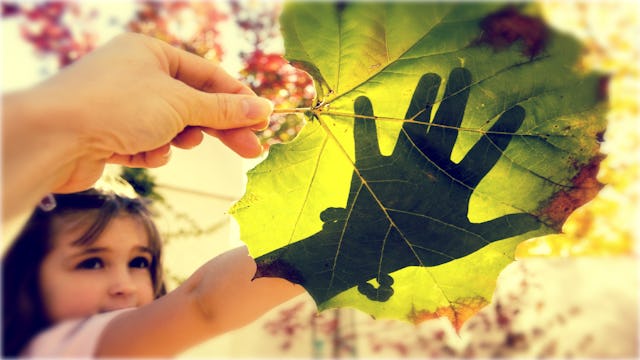Forest Schools Are The Teaching Trend We Should Get On Board With

I can tell when my kids don’t get enough outdoor time. They get antsy; they start to bicker. Their tendency to make enormous messes increases and their patience decreases. Meltdowns abound in all of them, especially my four-year-old. “They haven’t had a chance to run around, have they?” my husband will say as I stand, near tears, surrounded by the chaos of penned-up children. Something will click. I’ll nod miserably.
We know the natural world is good for kids. More than that, we know they need it.
As The Child Mind Institute says, it’s unclear exactly how this works, but we know that unstructured outdoor play in a natural setting builds confidence, that it gives kids a feeling of agency and control. It enhances creativity, possibly because of the infinite possibility of materials and kids’ ability to design their own activities; it teaches responsibility and provides different stimulation. In other words, it provide stimulation from something that doesn’t blare at them from a screen, something without sharply moving lights and colors.
Outdoor play makes kids think and encourages creative problem-solving, and it’s been proven to lower stress levels and fatigue. Who doesn’t want more of this for their kids?
Scratch that question. How do we get more of this for our kids?
One key answer: we need more forest schools. And we need them now.
Forest schools, according to the Loughborough University’s Media Centre, are a concept that came out of Scandinavia, “where schools use local woodland areas to hold outdoor activities which foster children’s problem-solving and cooperation skills, as well as their confidence and self-esteem.” They’re most common in the lower grades — what we would call primary school.
However, a recent study conducted by the University’s Dr. Janine Coates and Dr. Helena Pimlott-Wilson found that forest schools for both 4 to 5-year olds and 8 to 9-year-olds “can contribute to the development of collaborative learning skills, by encouraging children to work with others on challenging outdoor activities … [and] equip children with practical skills and an appreciation for being outdoors.”
These schools deemphasize the rat race academic achievement in favor of “giving a more rounded educational experience.” One principal said that it actually contributes to giving children “a positive mindset towards school.”
Basically, forest schools do all this by getting kids outdoors. Kids go into the woods three to four days a week, where they are “given opportunities to explore the area, learn to identify the flora and fauna, as well as make fires, build dens and climb trees. The space makes use of sustainable resources, including a fire circle built from local wood, and bug and hedgehog ‘hotels’ made from naturally sourced materials.”
Basically, they explore their environment and connect with nature and each other. Some activities are structured, some are not.
“Children won’t bounce off the walls if you take away the walls,” says Erin Kenny, founder of the American Forest Kindergarten Association. They believe “ programs for physical exposure to the natural world [should be] an essential component of early childhood education on a national level.”
They require a minimum of 1-3 hours of unstructured nature play; child-led learning, in which kids direct the curricula and the things they’ll explore in the classroom; inquiry-based teaching, with teachers as “guides, not the center of the classroom;” and data collection to determine what the kids are responding to, as well as possible sharing with parents and lending credibility to the school.
Sounds totally legit to me.
With all the benefits of forest schools, it’s clear we need more here in the United States. The American Forest Kindergarten Association only registers about fifty schools, and those are preschool or kindergarten programs. And though many offer intermittent programs for older kids, there are few that allow children this kind of unstructured access to nature on a regular basis.
According to several sources, including Inhabit, up to 10% of all early childhood programs in Scandinavia are held outdoors. They lead America in almost all educational measures, and perhaps this is one of the reasons.
Little children in Denmark “literally climb to the top of the treetops and whittle things with knives,” yet a teacher says he’s only taken one kid to the hospital in 18 years — when a boy had his foot run over in the parking lot. Could this trust, adventurism, creativity and drive translate into better academics, better social skills, and even better mental health? Science is hinting at yes.
America’s a land of green space. Rapidly disappearing, true, but green space nonetheless — and many forest kindergartens here are held in existing parks. Yes, it’s easy to let kids loose in the woods, but harder to make sure they enjoy guided learning and child-led learning while they do it. It requires teacher training. It requires a change in our mindset that play is worthless and only serious, factory-modeled work will help out children learn. It requires a shift in our sense of evaluation — no more would we have easy numbers to spit at politicians and parents. But our kids, who, according to The Child Mind Institute, get only 4-7 minutes of outdoor playtime, but 7 hours of screen time a day, need it.
Heck, our entire society needs it.